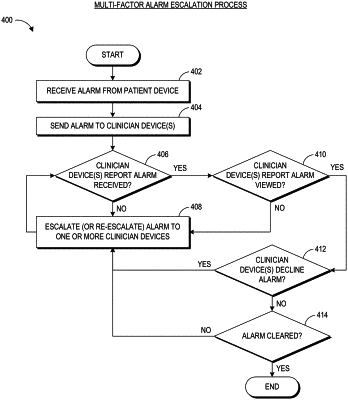| CPC G16H 40/67 (2018.01) [G16H 10/60 (2018.01); G16H 50/30 (2018.01); G16Z 99/00 (2019.02); G16H 40/20 (2018.01)] | 16 Claims |

|
1. A method of managing alarm notifications, the method comprising:
by a multi-patient monitoring computing device comprising physical computer hardware:
sending an alarm notification message to a clinician device associated with a first clinician;
determining whether a first indication that the alarm notification message was received by the clinician device has been received from the clinician device;
in response to not receiving, from the clinician device, the first indication, accelerating escalation of an alarm associated with the alarm notification message;
in response to receiving, from the clinician device, the first indication:
determining whether a second indication that the alarm notification message was viewed by a clinician user at the clinician device has been received from the clinician device, wherein the second indication indicates that the clinician user has viewed but not yet responded to the alarm notification message;
in response to not receiving, from the clinician device, the second indication, accelerating escalation of the alarm; and
in response to receiving, from the clinician device, the second indication:
determining whether a response responsive to a user input, provided by the clinician user at the clinician device, indicating that the clinician user has declined handling the alarm has been received from the clinician device;
in response to receiving, from the clinician device, the response responsive to the user input, accelerating escalation of the alarm; and
in response to not receiving, from the clinician device, the response responsive to the user input:
determining whether the alarm has been cleared; and
in response to determining that the alarm has not been cleared, accelerating escalation of the alarm;
determining whether or not an escalation condition is present based at least in part on at least one of: receipt or non-receipt of the first indication from the clinician device, receipt or non-receipt of the second indication from the clinician device, or receipt or non-receipt of the response from the clinician device; and
in response to determining that the escalation condition is present, automatically escalating the alarm by sending the alarm notification message to a second clinician device associated with a second clinician.
|